The second segment of Honolulu's Skyline rail is opening on October 16th, adding five miles and four new stations to the existing guideway, including a stop at Daniel K. Inouye International Airport. This expansion, however, marks a significant shift in the initial project vision, with the airport connection not being a foregone conclusion early on. The expansion adds only five miles and four stations to the Skyline guideway, but city officials have high hopes for what the second segment will bring to the project. “For me, this is really the ultimate in providing quality of life opportunities, economic-wise, economically, time-wise, it’s just going to lend a whole different dynamic,” said Honolulu Mayor Rick Blangiardi, according to Hawaii News Now.
The choice to include the airport in the second phase of the Skyline project is expected to bring a boost in ridership, particularly with the direct connection to the airport. This will have important implications for the tourism sector, potentially easing traffic congestion for visitors arriving and departing from the island. Further, convenient rail access could encourage tourists to explore areas beyond Waikiki via public transport, benefiting local businesses in different neighborhoods. The City and County of Honolulu took local media on a trial run of Skyline rail Segment 2 on Thursday, a week in advance of its launch to public ridership, according to ny1.com.
The project faces ongoing challenges. Some have criticized the rail project, with the Civil Beat highlighting that the debates about the rail system date back six decades. Issues surrounding construction costs, and route selections have been ongoing points of contention. Moreover, the provision of key amenities such as escalators at stations is being reconsidered to manage associated costs as reported by Hawaii Free Press.
For local businesses, the rail expansion presents both opportunities and potential disruptions. Businesses located near the new stations can anticipate increased foot traffic and a potential boost in sales. However, companies might face challenges related to infrastructure changes. Overall, as the rail system evolves, local businesses need to remain informed about its impact to adjust strategies and maximize the benefits of enhanced connectivity across Oahu.



